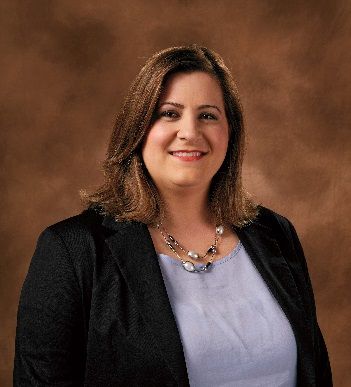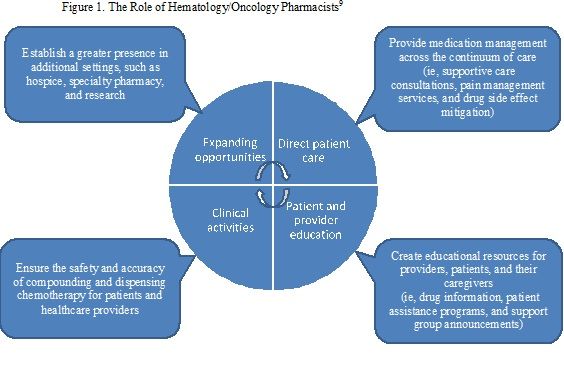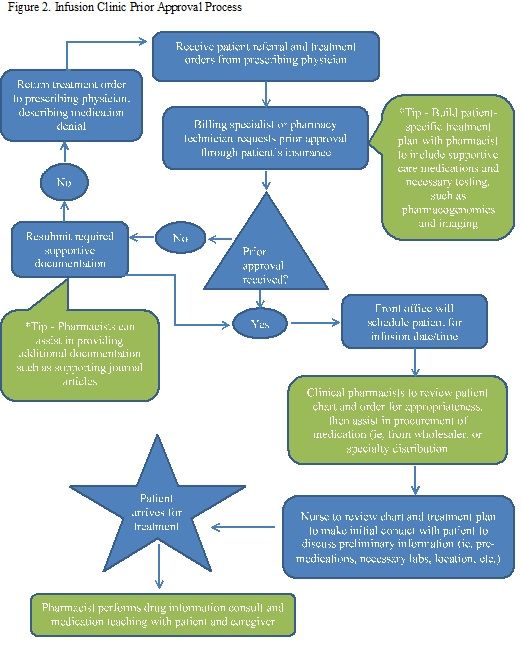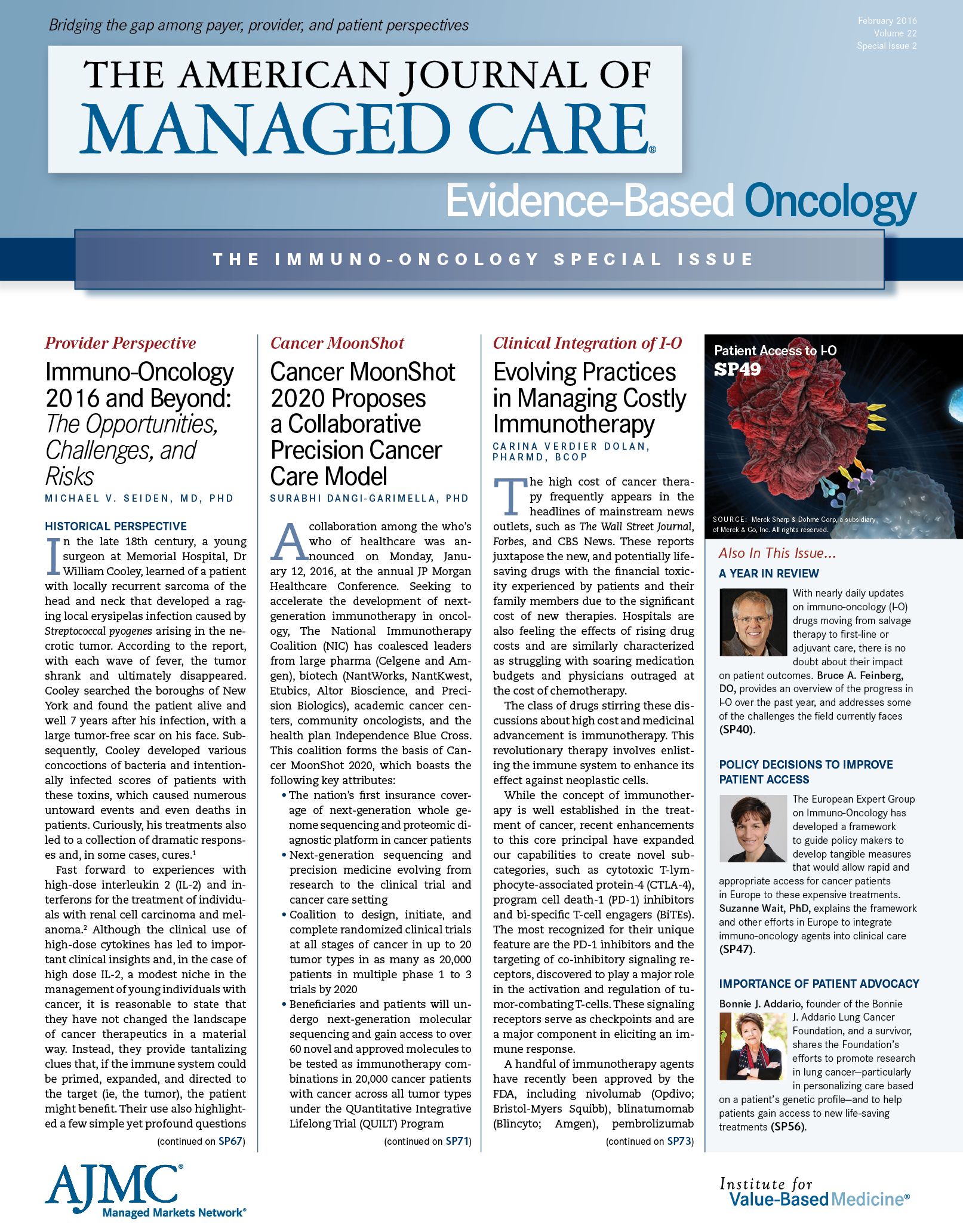- Center on Health Equity & Access
- Clinical
- Health Care Cost
- Health Care Delivery
- Insurance
- Policy
- Technology
- Value-Based Care
Evolving Practices in Managing Costly Immunotherapy
To address the nationwide concern of costly immunotherapy agents, this article features health system inpatient and outpatient strategies that can help mitigate their costs.

The high cost of cancer therapy frequently appears in the headlines of mainstream news outlets, such as The Wall Street Journal, Forbes, and CBS News. These reports juxtapose the new, and potentially lifesaving drugs with the financial toxicity experienced by patients and their family members due to the significant cost of new therapies. Hospitals are also feeling the effects of rising drug costs and are similarly characterized as struggling with soaring medication budgets and physicians outraged at the cost of chemotherapy.
The class of drugs stirring these discussions about high cost and medicinal advancement is immunotherapy. This revolutionary therapy involves enlisting the immune system to enhance its effect against neoplastic cells.
While the concept of immunotherapy is well established in the treatment of cancer, recent enhancements to this core principal have expanded our capabilities to create novel subcategories, such as cytotoxic T-lymphocyte-associated protein-4 (CTLA-4), program cell death-1 (PD-1) inhibitors and bi-specific T-cell engagers (BiTEs). The most recognized for their unique feature are the PD-1 inhibitors and the targeting of co-inhibitory signaling receptors, discovered to play a major role in the activation and regulation of tumor-combating T-cells. These signaling receptors serve as checkpoints and are a major component in eliciting an immune response.
A handful of immunotherapy agents have recently been approved by the FDA, including nivolumab (Opdivo; Bristol-Myers Squibb), blinatumomab (Blincyto; Amgen), pembrolizumab (Keytruda; Merck), and ipilimumab (Yervoy: Bristol-Myers Squibb), for the treatment of various types of cancers. Beyond their remarkable survival rates, in comparison to traditional treatments and standard of care, these therapies are most recognized for their unsustainable price tags. Since their approval, healthcare systems across the country have struggled to determine the most effective strategy to incorporate these important agents into practice, while mitigating their cost.
Panel Discussion at the Oncology Pharmacy Summit
To address this nationwide concern, Vizient, Inc (the new brand identity for the organizations formerly known as, VHA Inc, UHC, and Novation), hosted a roundtable discussion, during its 4th annual Oncology Pharmacy Summit, on member strategies to manage immuno-oncology (I-O). The Oncology Pharmacy Summit is intended to provide a forum for member organizations, particularly those with large oncology patient populations, to discuss current critical issues and future opportunities within the cancer care environment.
The roundtable discussion started with most participants describing the overwhelming speed with which these agents have hit the market. Pembrolizumab was the first agent to be approved on September 4, 2014, for the treatment of patients with advanced or unresectable melanoma who had progressed on previous therapy and were no longer responding to other drugs.1 In just 15 months, the PD-1 inhibitor has received 2 additional indications: for advanced non-small cell lung cancer (NSCLC), and most recently, an expanded indication to be included as first-line treatment in patients with unresectable or metastatic melanoma.2,3
The second agent in this class, nivolumab, was originally approved on December 22, 2014, for advanced melanoma. In just one year, it has achieved 4 additional indications including use in previously-treated squamous and non-squamous NSCLC, as part of a combination regimen with ipilimumab for untreated or unresectable advanced melanoma, and renal cell carcinoma in patients who have received prior therapy.4-7 The work the FDA has accomplished in approving 8 indications between 2 agents for 3 different cancer types has been impressive, but has left insurance providers struggling to keep up with the labelled indications of these products, much less the off-label circumstances in which they are currently being considered.
Panelists also noted the rapid release of preliminary clinical trial announcements of I-O agents. These therapies are currently being tested in several different conditions, such as ovarian cancer, Hodgkin’s lymphoma, and head and neck cancer, and are likely to yield results in the near future. Research is also being conducted on the sequence of combined modalities including surgery, radiation, traditional chemotherapy, and other new targeted drugs. The use of this innovative group of drugs will continue to surge as study results are confirmed and applications broaden. Therefore, the need to define effective strategies to evaluate and monitor use of these drugs will only continue to expand. One particular program was universally endorsed by all panelists as an essential component of managing these therapies—the employment and placement of clinical pharmacists in ambulatory clinics and in-patient service lines to assist physicians with appropriate dosing and monitoring of cancer patients.
The Role of Oncology Clinical Pharmacists
Figure 1
Clinical pharmacists are the frontline defenders in effective medication utilization and are paramount in the therapeutic decision-making process. One study has shown that adding a clinical oncology pharmacist to a community oncology clinic resulted in a cost saving of $210,000 in patient charges by preventing drug waste, reducing chemotherapy dosages, and rounding to the nearest vial size, where appropriate.8 Clinical pharmacists function as gatekeepers, actively reviewing patients’ medical records to determine acceptable medication use in compliance with the health system pharmacy and therapeutics (P&T) formulary management, as well as employing dose-rounding strategies to ensure a reduction in drug waste ().

A strategy in place at many institutions—and imperative to a health system—in managing this class of drugs is inpatient and outpatient drug formulary management. Policies to evaluate each medication, and resulting reimbursement for inclusion on the formulary, can greatly impact the economic bearings to the healthcare system and assist in dictating patient-specific utilization.
Inpatient and outpatient practices significantly differ in their reimbursement methods. Below are additional strategies for mitigating the cost of immunotherapy categorized by site of administration.
Inpatient Practices for Mitigating the Cost of Immunotherapy
It is not unusual for physicians to request a continuation of medication that the patient is receiving, on an outpatient basis, while that patient is admitted to the hospital. Moreover, when a cancer patient is admitted to the hospital for emergency care, new treatment options can be prescribed and administered as a matter of convenience. However, some medications require administration inside a hospital to ensure close monitoring by healthcare professionals. Without a proactive and comprehensive approach to medication management via P&T formulary policies, pharmacists will be hard-pressed to balance true patient considerations with the economic consequences of medication administration outside of the most cost-effective setting.
Expert Committees to Oversee Approval of Drug Use
To assist in the system-wide organization and coordination of policies and procedures, designated committees, involving key stakeholders and experts within the institution, must be created to facilitate the approval of processes surrounding these expensive items.
1. High Drug Cost Committee
This multidisciplinary committee is formed in alliance with the P&T committee to evaluate medications that cost the healthcare system a large amount of money. The committee should include physicians, pharmacists, finance or reimbursement specialists, and administrator champions to set policies and procedures documenting which marketed drugs will be evaluated using a scoring system to grade each medication, including available clinical data and pricing information. Additional factors, such as limited distribution channels and specialty pharmacy should also be considered. Each evaluation will determine the medications that will be allowed to be administered in-house as compared with those restricted to outpatient use only. It is important to remember that there remains no universal definition of a “high cost” drug. Rather, each organization must define the threshold above which this additional level of scrutiny will be applied.
2. Off-label Use Committee
Frequently, medications are studied in supplemental disease states beyond the conditions for which they were initially approved. The Off-label Use Committee is designed to approve the use of medications for an off-label indication. The team can be comprised of prominent chief medical officers and high-ranking pharmacy administrators, including a drug information officer. Physicians who submit an application for off-label administration should also be required to provide evidence-based proof of therapeutic validity. A decision on the submission-for-use should be reported to the applicant within 48 hours to provide real-time support and feedback.
3. Oncology Subcommittee
As a division of the formal P&T Committee, the oncology subcommittee includes lead oncology physicians and pharmacists throughout the healthcare system. This group convenes to discuss the clinical and operational aspects of oncolytics and supportive care medications used to treat cancer. They can make recommendations on agents to be added to the formulary or non-formulary, as well as participate in quality assurance, informatics, and therapeutic equivalence activity. Given the anticipated product pipeline, this group could help lead an organization’s initial level of understanding and familiarity with the biosimilar pipeline.
Outpatient Practices for Mitigating the Cost of Immunotherapy
Figure 2
In contrast to the inpatient diagnosis-related group codes for the purposes of hospital payment, the primary mechanism in ambulatory settings for authorization of drug regimens is the approval by a patient’s insurance company. Multiple services can be used to ensure accurate payment for drugs and to improve the overall fiscal responsibility of an infusion clinic ().

1. Insurance Approval
Receiving prior authorization on a patient’s medications and services, prior to delivery, is an excellent method of verifying reimbursement for the patient. Employment of a billing specialist, with support provided by a pharmacist or pharmacy technician, can capture drug payments and prevent loss of significant revenue to the infusion clinic. While this service may incorporate additional steps, it can provide a preventive measure to ensure maximum allowable compensation.
2. Patient Assistance Programs
Patient assistance programs originated to provide a means to supply medications to patients with low income, a lack of health insurance, or a gap in prescription plan coverage. These programs are often funded by drug manufacturers and require the patient to meet an eligibility criterion to be accepted in the program. This avenue can provide auxiliary medications to the pharmacy that would have otherwise been a cost to the pharmacy budget. Participating in medication replacement programs are a cost-effective measure for the infusion clinic, and the patients they serve.
3. Medication Billing
Depending on the services and infusions the clinic provides, it may be necessary to adopt a multi-billing system approach to maximize reimbursement. Outpatient account billing is an intricate process of submitting national drug codes with correct billing units and physician services in correlation with documentation. One step during the submission process is accounting for the amount of drug used for treatment. During the compounding process of intravenous medications, it may be necessary to dispose of a portion of unused drug. Insurance providers may allow for compensation of this remaining portion. It is important to have regular discussions with the finance department with regards to multi-billing approaches, including but not limited to, appropriateness of billing for waste, previously rejected claims, and updated code and billing unit information.
Conclusion
Cancer immunotherapy has the potential to produce lifesaving treatments for patients, but at a great expense. Managing the high cost of cancer therapy requires a dedicated multidisciplinary team of physicians, pharmacists, social workers, and finance to learn, organize, and execute strategies for a successful program. The programs suggested above are pertinent, not only to costly oncology therapies, but also to other disease states that require expensive treatments. Such programs must be present and highly functional in order to address the staggering cost of today’s medications and to prepare for the clinical future of I-O with combination therapy. To continue to provide patients with contemporary treatment options, healthcare providers must remain at the leading edge of cost-containment approaches.
Acknowledgments
EBO
The content for this article was provided by panelists participating in a roundtable discussion of strategies to manage the cost of I-O therapy held as part of Vizient’s Oncology Pharmacy Summit on November 4, 2015. Participating in the discussion were, Osama Abdelghany, PharmD, Yale-New Haven Hospital; Joseph Bubalo, PharmD, Oregon Health & Science University; Steve Fijalka, PharmD, University of Washington Medical Center/ Seattle Cancer Care Alliance; Scott Silverstein, MS, RPh, Huntsman Cancer Center Institute at the University of Utah; Bruce Vinson, PharmD, Cedars-Sinai Medical Center; and Robert Wolf, PharmD, RPh, Mayo Clinic.
Carina Verdier Dolan, PharmD, BCOP, is senior clinical manager, Vizient, Inc.
Address for correspondence
Carina Verdier Dolan, PharmD, BCOP
Vizient, Inc.
290 E. John Carpenter Fwy.
Irving, TX 75062
References
E-mail: cdolan@novationco.com
- FDA approves Keytruda for advanced melanoma [press release]. Silver Spring, MD: FDA; September 4, 2014. http://www.fda.gov/NewsEvents/Newsroom/PressAnnouncements/ucm412802.htm.
- FDA approves Keytruda for advanced non-small cell lung cancer [press release]. Silver Spring, MD: FDA; October 2, 2015. http://www.fda.gov/NewsEvents/Newsroom/PressAnnouncements/ucm465444.htm.
- Pembrolizumab label updated with new clinical trial information. FDA website. http://www.fda.gov/Drugs/InformationOnDrugs/ApprovedDrugs/ucm478493.htm. Published December 2015. Accessed December 30, 2015.
- FDA approves Opdivo for advanced melanoma [press release]. Silver Spring, MD: FDA; December 22, 2014. http://www.fda.gov/NewsEvents/Newsroom/PressAnnouncements/ucm427716.htm.
- FDA expands approved use of Opdivo in advanced lung cancer [press release]. Silver Spring, MD: FDA; October 9, 2015. http://www.fda.gov/NewsEvents/Newsroom/PressAnnouncements/ucm466413.htm.
- Nivolumab in combination with ipilimumab. FDA website. http://www.fda.gov/Drugs/InformationOnDrugs/ApprovedDrugs/ucm465274.htm. Published October 2015. Accessed December 19, 2015.
- FDA approves Opdivo to treat advanced form of kidney cancer [press release]. Silver Spring, MD: FDA; November 23, 2015. http://www.fda.gov/NewsEvents/Newsroom/PressAnnouncements/ucm473971.htm.
- Rudner AD, Smith DL, Madsen MT, Kass FH 3rd. Is there a benefit to having a clinical oncology pharmacist on staff at a community oncology clinic? J Oncol Pharm Pract. 2011;17(4):425-432. doi: 10.1177/1078155210389216.
- The role of hematology/oncology pharmacists. The Hematology/Oncology Pharmacy Association (HOPA) website. http://www.hoparx.org/uploads/Health_Policy/2014/HOPA_About_Hem_Onc_Pharmacist_Issue_Brief_FINAL.pdf. Published August 2014. Accessed January 7, 2016.

Trends in Hospital Pricing for Vulnerable Emergency Department Users, 2021-2023
December 4th 2025Self-pay emergency department prices rose significantly from 2021 to 2023, especially at for-profit and system-affiliated hospitals, highlighting growing affordability challenges for uninsured and underinsured patients.
Read More

